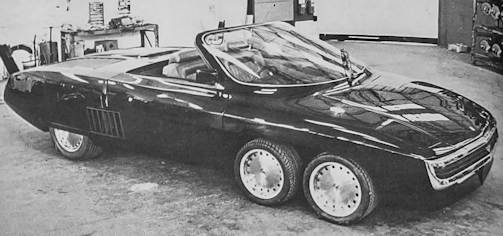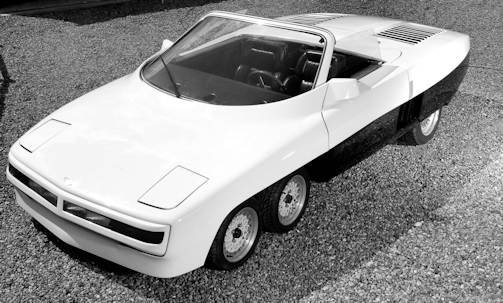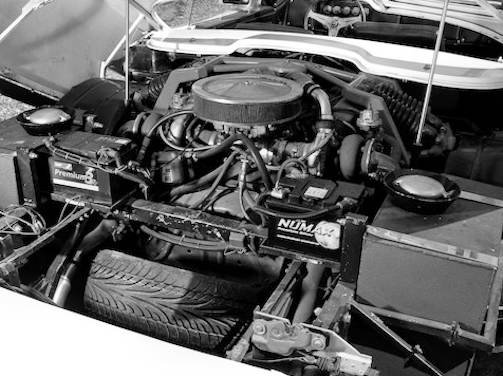Panther 6 six wheel car history
 |
|
|
Manufacturer |
Panther Westwind’s Ltd |
|
Production |
1977 to 1978 |
|
Produced |
2 |
|
Assembly |
Weybridge, England |
|
Body style |
2-door convertible |
|
Layout |
RMR layout |
|
Engine |
V8 8.2L Cadillac |
|
Transmission |
3-speed automatic |
|
Wheelbase |
105.0 in (2,667 mm) |
|
Length |
192.0 in (4,877 mm) |
|
Width |
80.0 in (2,032 mm) |
|
Height |
48.0 in (1,219 mm) |
|
Curb weight |
2,870 lb (1,302 kg) |
|
Designer |
Robert Jankel |
The Panther 6 was an unusual road sports car produced by the British car manufacturer Panther from the 1970s.
History
The Panther 6 was primarily designed and built to draw public attention to the company. It was largely self-constructed in 1976 by Robert Jankel, the company's owner. its most striking feature that had six wheels with cabriolet body type and only a three-seater. Other eye-catching design features were a body-coloured front bumper with wide embedded lighting units. The main headlights could be folded out. Features included a detachable hard top and convertible soft top, hi tech electronic instruments, air conditioning, electric seats and windows and even an automatic fire extinguisher, The car had a large panoramic window and sunken wipers. Inside, two telephones were installed in the doors, and there was a television set in the dashboard.

The Panther 6 was presented to the public at the 1977 London Motor Show in Earls Court and it unique looks caused a great stir there. A total of only two examples of the Panther 6 were built within eight years. Both were painted differently over the years.
The first vehicle was a right-hand drive, painted black. It had a single bench seat with three seats and featured a column shifter. The vehicle took up the design concept of the Tyrrell P34, which caused quite a stir in the Formula 1 World Championship from 1976, and implemented it in the field of road vehicles.
The second vehicle was left-hand drive with two individual seats and a centre shift. Panther began building the second car in 1978; However, the company soon ran into financial difficulties and was initially unable to complete the car. The second 6 was not completed until Panther was already in receivership. It primarily served to develop additional funds for the company through the sale of the car. The car was sold in 1985 for £150,000 later painted white and black.

The car had two steered front axles with four small 205/40 VR13 tires and one rear axle with two significantly larger tires. The front suspension was independent with wishbones and coil springs fitted with anti-roll bar and telescopic dampers at the rear also independent, wishbones, coil springs, anti-roll bar and telescopic dampers.
The wheelbase from the second front axle to the rear axle is 2667. The vehicle is 4877 mm long, 2032 mm wide and 1219 mm high. The curb weight is given as 1302 kg.
The vehicle was powered by an 8.2-litre, twin-turbocharged with 2 Airesearch T04 turbochargers to a Holley downdraught carb the eight-cylinder engine sourced from Cadillac mid-mounted above the rear axle. The factory specified the power of the engine as 600 hp; the top speed should be 200 miles per hour (about 320 km/h). A General Motors three-speed automatic transmission served as power transmission gearbox Turbo-Hydramatic 425 automatic with hydraulic torque converter and 3 ratios with possible manual selection.

Claims for the top speed of this vehicle suggested it was capable of over 200 mph (322 km/h); however, these claims are so far unsubstantiated.
It is doubtful whether series production was planned. A major problem along the way was the small front tires that Pirelli had made exclusively for this vehicle and which would have been very expensive to produce.
Technical
-
Panther 6 Technical details and specifications (1977-1978)
ENGINE
Cadillac, location central
4 stroke; 8 cylinders, Vee-slanted at 90°
Engine capacity: 500 cu in, 8,194 cc
bore and stroke: 4.30 x 4.30 in, 109.1 x 109.1 mm
compression ratio: 8.5:1
cast iron block and head
5 crankshaft bearings
valves: overhead, in line, push-rods and rockers, hydraulic tappets
camshafts: 1, at centre of Vee
lubrication: gear pump, full flow filter, oil cooler
Total oil capacity 10 imp pt, 12 US pt
2 Airesearch T04 turbochargers with 1 Holley downdraught a-barrel carburettor water-cooled 2 electric fans
max speed: over 200 mph, 322 km/hTRANSMISSION
driving wheels: rear
gearbox: Turbo-Hydramatic 425 automatic transmission, hydraulic torque converter
3 ratiospossible manual selection
ratios: 1st 2.480, 2nd 1.480, 3rd 1. rev 2.090
gear lever location: steering column
final drive: spiral bevel
axle ratio: 1.800CHASSIS
tubular
front suspension: independent, wishbones, coil springs. anti-roll bar. telescopic dampers
rear: independent. wishbones. coil springs, anti-roll bar, telescopic dampers.STEERING
rack-and-pinion, servo
turns lock to lock: 2.80.BRAKES
disc (front diameter 10 in, 25.4 cm, rear 11 in, 27.9 cm), 3 circuits
swept area: front 400 sq in, 2,580 sq cm
swept area: rear 224 sq in, 1,445 sq cm
swept area: total 624 sq in, 4,025 sq cm
ELECTRICAL EOUIPMENT
12 V
66 Ah battery
100 A alternator
4 halogen headlamps.DIMENSIONS AND WEIGHT
wheel base: 105 in, 267 cm
tracks: 61.50 in, 156 cm front, 64.50 in, 164 cm rear
length: 192 in. 487 cm
width: 80 in, 203 cm
height: 48 in, 122 cm
ground clearance: 7 in, 17.8 cm
weight: 2,870 1b, 1.302 kg
fuel tank: 30 imp gal, 36.2 US gal (2 separate tanks)© Motor car History
Service
-
Panther 6 Maintenance and Service Guide (1977-1978)
Fuel: 98 oct petrol
Oil: engine; 10 imp pt, 12 US pt
Automatic transmission fluid 10.3 imp pt. 12.3 US pt
Coolant capacity: 43.1 imp pt. 51.8 US pt
Final drive oil 3.3 imp pt, 4 US pt, 1.9 1.
Width of rims: 6" front. 9'rear
Tyres: P7 205/40 VR x 13 front, P7 265/50 VR x 16 rear© Motor car History
